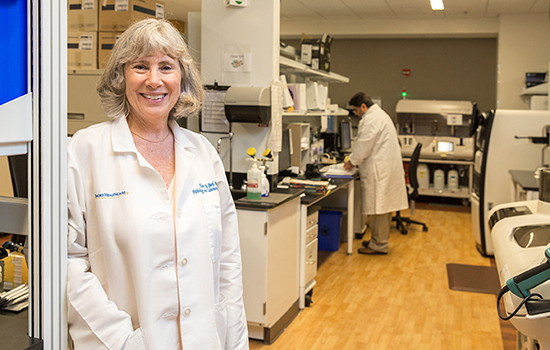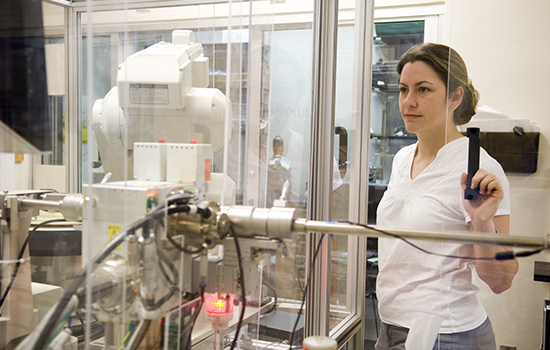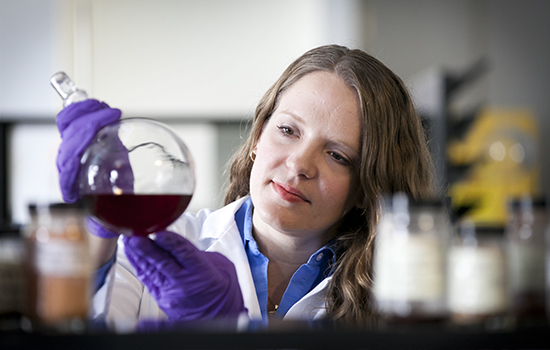A Future Without Antibiotics?
By Mary Loftus, Graphic Story by Jonathan Roy
VIEW GRAPHIC STORY HERE >>
The possibility that our most commonly prescribed drugs, which we've relied on for nearly eight decades to kill infections, will stop working—indeed, in some cases, already have — is nearly unfathomable.
 Each year, more than 2 million people in the United States become infected with bacteria that are resistant to antibiotics and about 23,000 of them die. "Unfortunately this problem is going to get worse before it gets better, and more people will die," says microbiologist David Weiss, director of Emory's Antibiotic Resistance Center. "If you can die from a scrape or a common infection, honestly, everyone's life is going to change a lot."
Each year, more than 2 million people in the United States become infected with bacteria that are resistant to antibiotics and about 23,000 of them die. "Unfortunately this problem is going to get worse before it gets better, and more people will die," says microbiologist David Weiss, director of Emory's Antibiotic Resistance Center. "If you can die from a scrape or a common infection, honestly, everyone's life is going to change a lot."
Commonplace illnesses and routine surgeries would once again become life-threatening, and chemotherapy, organ transplantation, and other tools of modern medicine would be off the table.
On these pages we have asked graphic artist Jonathan Roy, author of Smallpox Zero, to depict the past, present, and possible future of antibiotics, and we also profile several Emory Antibiotic Resistance Center researchers — our own Superbug Squad.
"We're standing on the precipice of a post-antibiotic era," says Emory ethnobotanist Cassandra Quave, who is searching for medicines in ancient remedies and promising plants. "We just haven't fallen off yet."

EILEEN BURD, professor of pathology and laboratory medicine and director of clinical microbiology at Emory University Hospital
Who I Am: I've been a clinical microbiologist for almost 20 years. My second youngest brother died of Haemophilus influenzae meningitis when he was three years old and I was six. I never cease to be amazed at how such tiny organisms can cause devastating disease.
What I Do: Now more than ever, the clinical microbiology laboratory is on the front line and plays a vital role in helping to heal people. My primary role as a clinical microbiology laboratory director is to ensure that my laboratory is using the best technology available to generate accurate, rapid, and cost-effective antimicrobial susceptibility test results. If antibiotic therapy is informed by these results, it should be effective most of the time and lessen the use of unnecessary antibiotics. If I encounter an unusual antibiotic-resistance phenomenon in the laboratory, I want to explore it further. This has happened on several occasions in the past few years.
Challenges: Clinical microbiology laboratories are highly regulated. This is necessary to ensure that quality results are obtained from all microbiology laboratories regardless of where they are located around the country, but sometimes inhibits our flexibility and responsiveness. Also, because of high research and development costs and lower profits for manufacturers if resistance eventually develops, there are fewer new antibiotics in production.
Fears: Resistance to at least one first-line antibiotic is now common and pan-resistant bacteria do exist. Infections that require the use of more toxic last-resort antibiotics are arising more frequently, and many of the antibiotics that have been developed over the last 80 years are useless in some situations. Unless new ways to kill pathogenic bacteria are discovered, it is feared that infections will return us to the days before antibiotics existed.
Solutions: International coordinated efforts are needed immediately. There need to be more clinical laboratories to identify the right antibiotics to treat infections, and tracking of cases so that data can be shared and authorities can make informed decisions about where to target their policy measures. Research is needed to fill in the gaps in our understanding of antibiotic resistance. Physicians need to prescribe antibiotics only when needed and infection control measures must be practiced universally.

CHRISTINE DUNHAM, structural biologist, assistant professor of biochemistry
Who I Am: I'm a basic scientist interested in how macromolecules work. We use interdisciplinary techniques including X-ray crystallography to take snapshots (or something like a picture) to answer what these proteins and nucleic acids look like and how they're regulated.
What I Do: We study two aspects of antibiotic tolerance. The first focuses on the ribosome, a major antibiotic target that bacteria acquire resistance to. In collaboration with Professor Graeme Conn's lab at Emory, we've been studying the molecular basis for antibiotic resistance. The second focus is how different cellular environments control bacterial proliferation and persistence.
Challenges: It has been known since the 1940s, when we identified penicillin to treat staph infections, that although penicillin kills a large percentage of the bacteria, a very small population survive. These bacteria have not acquired mutations but, for some unknown reason, they are tolerant; we call them "persisters." These bacteria are genetically identical to the bacteria that were killed—they just changed their behavior to become tolerant to antibiotics. This is extremely interesting from a biological standpoint but equally terrifying.
Fears: Without effective antibiotics, modern medicine is compromised. Most operations require the use of antibiotics to prevent infections. All biomedical advances we've made in the past 100 years rely on antibiotics. The number of people who die from bacterial infections is, I believe, being underreported. For example, my grandmother had a stroke and went to the hospital, where she got MRSA and ultimately died of pneumonia. Still, on her death certificate it says she died of a stroke. The immunocompromised, young, old, and pregnant will be the first to be impacted when effective antibiotics become scarce.
Solutions: There needs to be a resurgence in antibiotic research, which is beginning to happen. We need to revisit the mechanism of action of specific antibiotics that were removed from the clinic but were really effective at killing bacteria—we may be able to reduce their toxicity by changing their chemistry. The medical field discusses personalized medicine but personalized antibiotic treatments have not been emphasized to the same extent. We should all be advocating for appropriate antibiotic treatment. If someone goes to a doctor, they should resist antibiotics at all costs unless it is clear the infection is bacterial. Then, the type of bacterial infection should determine the antibiotics prescribed.
 JAMES HUGHES, co-director of the Emory Antibiotic Resistance Center and professor of medicine and public health at Emory
JAMES HUGHES, co-director of the Emory Antibiotic Resistance Center and professor of medicine and public health at Emory
Who I Am: I'm a physician trained in internal medicine and infectious disease, and was director of the National Center for Infectious Diseases at the CDC and a Rear Admiral and Assistant Surgeon General in the US Public Health Service before coming to Emory.
What I Do: Investigate emerging antimicrobial resistance at the interface of human health, animal health, and environmental health.
Challenges: Overcoming the lack of public and policymaker understanding of the seriousness of the threat of multidrug resistance and the urgency of addressing it. The WHO tagline for World Health Day in 2011 captures it: "No action today, no cure tomorrow."
Fears: We are at risk for returning to the pre-antibiotic era when patients died of untreatable infections caused by superbugs. Imagine the implications this would have for seriously ill patients who need cancer treatment, organ transplantation, management of autoimmune disorders, or ICU care.
Solutions: Surveillance, infection prevention and control efforts, judicious antibiotic use through stewardship, development of rapid diagnostic tests for use at the bedside or in the clinic, new antibiotics and alternative therapeutic approaches, improved delivery of available vaccines and development of new vaccines, improved sanitation and hygiene, educational efforts, public-private partnerships (including academic institutions), and sustained political will to address this challenge.
 JESSE JACOB, associate professor of medicine and Hospital Epidemiologist at Emory University Hospital Midtown.
JESSE JACOB, associate professor of medicine and Hospital Epidemiologist at Emory University Hospital Midtown.
Who I Am: As an infectious diseases clinician, I lead Emory's Prevention Epicenter, a CDC-funded program that seeks to make health care delivery safer through improved hand hygiene and better use of personal protective equipment (gowns, gloves, and the higher-level gear used for infections like Ebola).
What I Do: I study patterns of infections, why they happen, and how they can be prevented in health care settings. I am particularly interested in multi-drug-resistant pathogens, particularly CRE (a strain of E. coli seemingly resistant to all known antibiotics), and how they are transmitted.
Challenges: One of the most basic ways to prevent infections is hand cleaning, but for busy nurses, doctors, and other health care workers this is challenging because they do it so often, yet there are still many missed opportunities. Antibiotic resistance is a hidden problem that people don't really see unless they have a personal experience, and even then it's often tied to other events. For example, if you have a serious infection after surgery or chemotherapy, the antibiotic-resistant infection is often not the focus—it's the cancer.
Fears: Not being able to treat patients with antibiotics that work. It's a world where simple infections could once again kill.
Solutions: Better awareness, more data, better funding. The work of Emory's Antibiotic Resistance Center is helping to inform the whole spectrum of antibiotic resistance, from bench to bedside. Once we define the scope of the problem and what can be done, we'll need support to put the solutions in place.

CASSANDRA QUAVE, curator at the Emory University Herbarium, assistant professor of dermatology.
Who I Am: As a medical ethnobotanist, I study how people use medicinal plants for health and search for new bioactive compounds. I've done field research with traditional healers in the Peruvian Amazon as well as rural regions of Italy, Albania, and Kosovo.
What I Do: I work in the early discovery space for new antibiotics. My research group evaluates the bioactivity and chemical makeup of plants used for the treatment of infectious disease in traditional medicine. During the past five years, I've gathered hundreds of therapeutic shrubs, weeds, and herbs and taken them back to Emory for a thorough chemical analysis. We are looking for new chemical scaffolds that can either act as new antibiotics or improve the effectiveness of existing antibiotics.
Challenges: Securing funding to explore "outside the box" ideas on how natural products and plant extracts interfere with different bacterial systems. We need to stop the reckless use of antibiotics as growth-promoters in agriculture and their misuse in hospitals and veterinary clinics.
Fears: The impact antibiotic resistance will have on the most at-risk patients—young children, the elderly, cancer patients, surgical patients—as well as my own family, friends, and students. In just a generation, the communal memory of the challenges of the pre-antibiotic world has vanished. It's hard to imagine a world where small medical issues, such as minor cuts or throat infections, can become deadly, but this is a very real possibility if things don't change.
Solutions: We need to focus on the development of better diagnostics and therapeutics and to push the limits of our imagination past current strategies. In addition to looking for new antibiotics, we need to invest significant effort into other approaches that could achieve restoration of balance in the patient/host. In my lab, we focus on the discovery and development of compounds that block the production of bacterial virulence factors, such as toxins, that damage tissues and the immune system. This could potentially disarm the bacteria and allow the immune system and classic antibiotics to clear the infection. We've gotten all of the low-hanging fruit, and now we're going to have to work a lot harder. We have to go to the ends of the earth—the ocean, the ice shelf, the rain forest—anywhere we possibly can to find new natural drugs.

BILL SHAFER, professor of microbiology and immunology, co-director of the Emory Antibiotic Resistance Center
Who I Am: When I was nine, I developed a post-surgical infection that was cured with an antibiotic. My mother, an army nurse in England in the 1940s, told me about caring for wounded soldiers after surgery at a military hospital—before penicillin, many of her patients would die from infection; after penicillin, the death rate dropped substantially. Initially, the hospital did not have enough penicillin, so staff would collect the urine from a soldier who had been treated, recover the penicillin crystals, and re-administer them to a different patient. I did my doctoral dissertation on methicillin resistance and toxin production by Staphylococcus aureus (staph). My PhD adviser suggested I continue to work on antibiotic resistance because one day it would be a "big thing."
What I Do: For the past three decades, we have examined Neisseria gonorrhoeae (the bacteria that causes gonorrhea), and S. aureus (staph) for their ability to resist both classical antibiotics and host-derived antimicrobials. I am working on the mechanics by which bacteria develop resistance to antibiotics. Our work deals with drug efflux pumps (transport proteins) within cells. Our hypothesis is that if we can cripple the pumps, it would be possible to keep antibiotics in clinical practice that might otherwise be lost.
Challenges: I work in a very supportive environment, with colleagues dedicated to biomedical research. I do worry that federal funding for basic research, which provides tomorrow's cures, will wane. Will we have enough scientists in 10 or 20 years to continue the efforts?
Fears: Simply put, the impact on public health (not to mention to economies) will be enormous. In the 1990s I used to tell Emory medical students to talk to physicians who were in medical school before WWII because they were the last group of doctors in the pre-antibiotic era. I suggested this because these students were likely to be the first generation of physicians in the post-antibiotic era.
Solutions: Effective stewardship programs, educating the public and health care providers as to when antibiotics should be used, providing incentives to industry to make antibiotic development a priority, ramping up surveillance and diagnostics efforts, and a sustained effort in basic research. All of this will be costly for sure, but the consequences of not investing are too horrible to contemplate.

DAVID WEISS, microbiologist, director of the Emory Antibiotic Resistance Center, associate professor of medicine
Who I Am: I attribute my love of biology to childhood trips to the Central Park Zoo and the Museum of Natural History. I later became fascinated with how microscopic life-forms can overcome our powerful immune system and cause so much human suffering.
What I Do: I'm director of the Emory Antibiotic Resistance Center (ARC), a network of more than 35 faculty members that receives more than $10 million a year in research grants. We approach the problem of antibiotic resistance in novel and multidisciplinary ways, to find new methods to stop bacteria from causing disease.
Challenges: The problem of antibiotic resistance threatens our entire medical system. It's unfortunately going to get worse before it gets better. In addition to developing new drugs and using them wisely, we ultimately need to identify ways of preventing bacteria from becoming resistant to antibiotics..
Fears: My greatest fear is that once we again gain the upperhand over drug-resistant bacteria, we will repeat the mistakes that brought us to this point. We must not become complacent.
Solutions: There is no single or simple solution. Our efforts must be multi-pronged and collaborative, involving diverse experts, including researchers, doctors, and educators, as well as the public. Funding and support for research must be increased.
Video
The Emory Antibiotic Resistance Center was launched as a means of identifying and consolidating expertise on antibiotic resistance, an issue of increasing urgency and concern.






